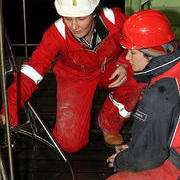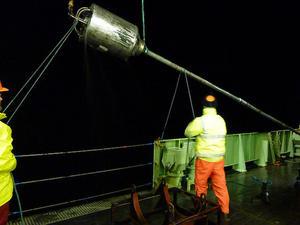Methane-rich sediments off South Georgia
The sediments just offshore Bird Island, South Georgia are rich in gases such as methane. We sampled this site last year on our way to the South Sandwich Islands and now have returned to complete our study of this area. We have just 24 hours to collect mud from the surface and longer tubes of sediment and to carry out of a survey of the seafloor using acoustic techniques and video. All hands to the deck for this last burst of activity before we return to Punta Arenas.

The gravity corer collects long tubes of mud, this one has a six-metre-long metal barrel which is powered into the sediment by the large weight on the top of the corer. The mud here is very compressible because it is gas rich and the sediment inside the barrel is rather distorted by this technique. The megacorer, however, collects the upper sediment without disturbing the mud properties and allows us to extract the gassy fluids and sieve out the burrowing fauna. The biologists count and archive the different species present in this amazingly high abundance, diverse Antarctic environment.
This is our last sampling site of our expedition. We have travelled over 5000-km on our voyage around the Southern Ocean and still have 2000-km, seven day passage back to Punta Arenas across the Drake Passage.
For more details on our voyage and links for Schools see www.thesearethevoyages.net/jc55.

